
French postcard, no. 7467. Leda Gys and Mario Bonnard in La pantomima della morte/The Pantomime of Death (Mario Caserini, 1915), scripted by Amleto Palermi.

Italian postcard by G.B. Falci, Milano, no. 300. Photo: Leda Gys as Mimì in La Bohème (Amleto Palermi, 1917).
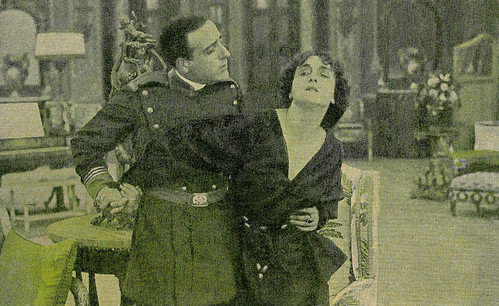
Spanish postcard by Amattler Marca Luna chocolate, series 7, no. 3. Photo: Lyda Borelli in Carnevalesca (Amleto Palermi, 1918).

Italian postcard by Vettori, Bologna. Photo: Rinasciento Film. Pina Menichelli and Luigi Serventi in Il romanzo di un giovane povero/The Story of a Poor Young Man (Amleto Palermi, 1920), based on the novel 'Le Roman d'un jeune homme pauvre' (1858) by Octave Feuillet.
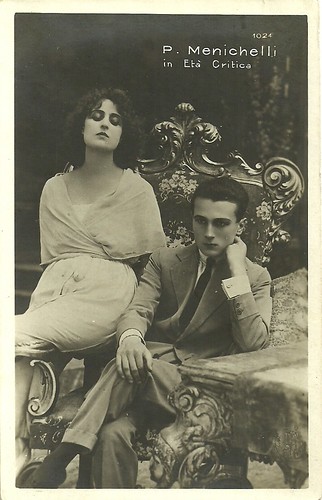
Italian postcard by Ed. Vettori, Bologna, no. 1024. Pina Menichelli and Giorgio Fini in L'età critica (Amleto Palermi, 1921). The film was based on the play by Max Dreyer, 'Die Siebzehnjährigen' (1904).

Italian postcard. Photo: Rinascimento Film. Livio Pavanelli, Orietta Claudi and Alfredo Bertone in La seconda moglie/The Second Wife (Amleto Palermi, 1922). Caption: Eliana amava il padre con affetto geloso (Eliana loved her father with jealous affection).
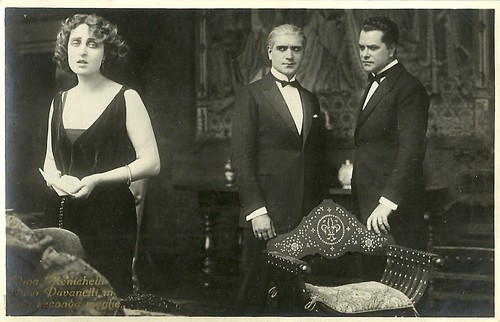
Italian postcard by Ed. G.B. Falci, Milano, no. 218. Pina Menichelli and Livio Pavanelli in La seconda moglie/The Second Wife (Amleto Palermi, 1922). The man in the middle is Alfredo Bertone. It is an adaptation of Arthur Wing Pinero's 1893 British play 'The Second Mrs Tanqueray', about a woman who struggles to overcome rumours about her past.
A confident, creative and skilful director
Amleto Palermi was born in Rome in 1891 and he grew up in Palermo. His father Raoul Vittorio Palermi was editor of the Giornale di Sicilia, and his mother Emilia Scarpelli was the sister of the Italian cartoonist, caricaturist, illustrator and journalist Filiberto Scarpelli. Amleto had two brothers, Manfredo and Italo. Barely twenty years old, Amleto wrote plays in Sicilian dialect such as 'U lupu', 'Amuri foddi' and 'Il tesoro d'isacco'.
In 1913, he moved to Rome, where he worked briefly as a journalist. The Turin-based production company Gloria Film then hired him. He worked on his first film, L'orrendo blasone (Amleto Palermi, 1914) with Mario Bonnard. For 'Film Artistica Gloria', he worked primarily as a director, but also as a scriptwriter for other directors.
Within a short space of time, he developed into an esteemed and distinguished filmmaker. He was sought-after by all the famous stars of the Italian silent cinema, including Mario Bonnard, Lyda Borelli, Livio Pavanelli, Pina Menichelli and Ruggero Ruggeri. Palermi was recognised for his confident acting, constant search for unusual solutions, creative use of narrative structures and (later) his skilful use of music and language, including dialect.
During the crisis in Italian cinema in 1926, he found work in Germany and Austria, where he directed a fair number of films. In 1929 he returned to Rome, with the advent of sound cinema. He directed around 35 more films until the beginning of the Second World War, initially some Italian-language versions of foreign productions, then - from around 1932 - works based on his own screenplays. He had great artistic freedom and was responsible for the editing of his films.
In 1941, Amleto Palermi died relatively young at the age of 51 of meningitis in Rome. He had three children with his wife Ida Molinaro, Fioretta Gioconda, Filippo (called Mimmo) and Francesco Saverio. Filippo (1917-1925) was a child actor in three films directed by his father: Paradiso (1923), La freccia nel cuore (1924), and La via del peccato (1924). He died of pneumonia in 1925, only 8 years old.

Italian postcard by G.B. Falci, Milano, no. 118. Photo: La Fotominio / Rinascimento Film / UCI. Pina Menichelli and Marcella Sabbatini in the drama La donna e l'uomo/The Woman and the Man (Amleto Palermi, 1923).
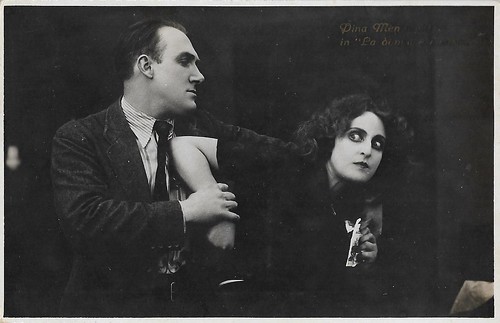
Italian postcard by G.B. Falci, Milano. Photo: La Fotominio / Rinascimento Film / UCI. Pina Menichelli and Milton Rosmer in La donna e l'uomo/The Woman and the Man (Amleto Palermi, 1923).
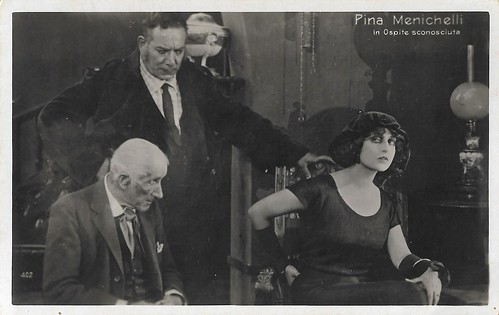
Italian postcard by G.B. Falci, Milano. Photo: Fotominio, no. 402. Pina Menichelli and Giovanni Grasso in Malafemmina, a title unknown to IMDb, but it is the alternative title of L'ospite sconosciuta/The Unknown Guest (Telemaco Ruggeri, 1923). Amleto Palermi wrote the script.
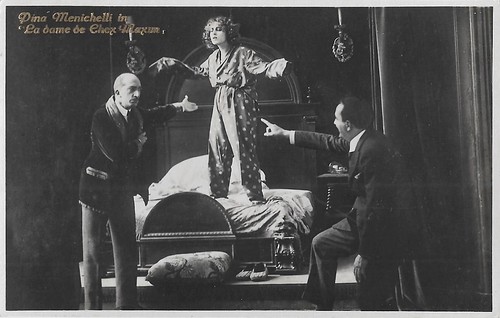
Italian postcard by G.B. Falci, Milano, no. 253. Pina Menichelli and Marcel Lévesque in La dama de Chez Maxim's (Amleto Palermi, 1923). Menichelli played the legendary Môme Crevette in one of the many film adaptations of Georges Feydeau's classic boulevard comedy 'La Dame de chez Maxim'(1899) .
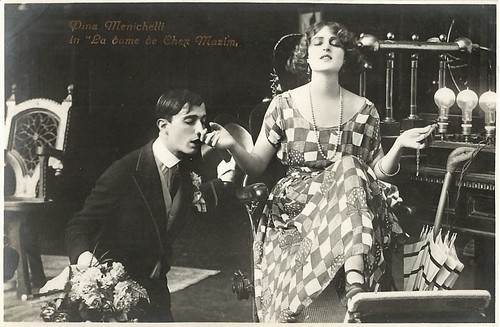
Italian postcard by G.B. Falci, Milano. Pina Menichelli in La dama de Chez Maxim's (Amleto Palermi, 1923). Menichelli played the legendary Môme Crevette in one of the many film adaptations of Georges Feydeau's classic boulevard comedy. The man may be Alfredo Menichelli, Menichelli's younger brother, who plays the young duke.

Italian postcard by G.B. Falci, Milano, no. 258. Pina Menichelli and Livio Pavanelli in one of Menichelli's last films La biondina/The Blonde (Amleto Palermi, 1923), based on a book by Marco Praga on the tragedy of a woman whose husband kills her in the end. It seems that Italian censorship forced the scriptwriter to add morality to the film, so Praga's tragedy is framed within a story about a modest, conventional wife who, encouraged by her friend, dreams of breaking out, but then reads Praga's book and decides to remain honest and loyal.

Italian postcard by Ed. A. Traldi, Milano. Photo: S.A.I.C. Ruggero Ruggeri in L'uomo più allegro di Vienna/The Most Cheerful Man in Vienna (Amleto Palermi, 1925).
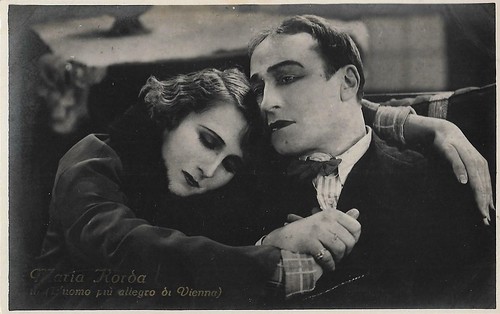
Italian postcard by G.B. Falci, Milano, no. 349. Photo: Palermi Films / La Fotominio. Maria Corda and Ruggero Ruggeri in L'uomo più allegro di Vienna/The Most Cheerful Man in Vienna (Amleto Palermi, 1925). The plot is quite moralistic but also modern: a young girl (Corda) is easily attracted to a fancy life by a gigolo (Varconi) but her father (Ruggeri), a happy-go-lucky leader of a jazz band, energetically manages to subtract her from dangers, even if all the relatives think he is a good-for-nothing.

Italian postcard by G.B. Falci, Milano, no. 364. Photo: A.P. Film / La Fotominio. Emilio Ghione and Kally Sambucini in La via del peccato/The Way of Sin (Amleto Palermi, 1925). Sambucini's first name is misspelt on the card.

Italian postcard by Ed. A. Traldi, Milano / Edizione E.F.A., no. 944. Enrica Fantis in Die Flucht in die Nacht/Enrico IV/The Flight in the Night (Amleto Palermi, 1926), based on Luigi Pirandello's play 'Enrico IV' The film starred Conrad Veidt, and was shot on location in Tuscany in Italy.
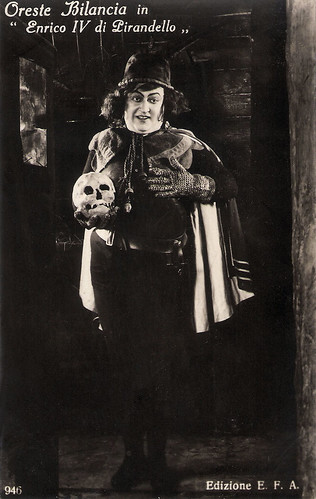
Italian postcard by Edizione A. Traldi, Milano, no. 946. Oreste Bilancia in Die Flucht in die Nacht/The Flight in the Night (Amleto Palermi, 1926), based on the play 'Enrico IV' by Luigi Pirandello.

German postcard by Ross Verlag, no. 1344/1, 1927-28. Photo: Hisa Film-Vertrieb. Victor Varconi (aka Viktor Varkony and Michail Varkonyi) as Glaucus in Gli ultimi giorni di Pompei/The Last Days of Pompeii (Carmine Gallone, Amleto Palermi, 1926), released in Germany as Die letzten Tage von Pompeji. The film was one of the many adaptations of the novel 'The Last Days of Pompeii' (1834) by Edward George Bulwer-Lytton. Sets were by Vittorio Cafiero, costumes by Duilio Cambellotti.

German postcard by Verlag Ross, Berlin, no. 1345/1, 1927-1928. Rina de Liguoro as Ione in Gli ultimi giorni di Pompei/The Last Days of Pompeii (Carmine Gallone, Amleto Palermi, 1926), released in Germany as Die letzten Tage von Pompeji.
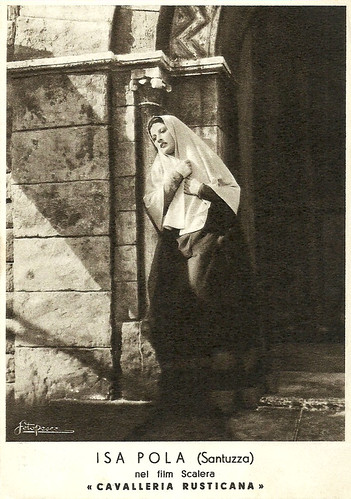
Italian postcard. Photo: Pesce / Scalera Film. Isa Pola as Santuzza in Cavalleria rusticana (Amleto Palermi, 1939). Pola and Leonardo Cortese had the leads as Santuzza and Turiddu in this drama based on the work of Giovanni Verga, which later was turned into an opera by Pietro Mascagni.

Italian postcard by Zimncografica, Firenze. Sent by mail in 1939. Photo: Scalera / Pesce. Leonardo Cortese in Cavalleria rusticana (Amleto Palermi, 1939).

Romanian or Italian postcard. Roberto Villa as Nemorino in L'Elisir d'amore/The Elixir of Love (Amleto Palermi, 1941).
Sources: Wikipedia (Italian, German and English) and IMDb.
No comments:
Post a Comment